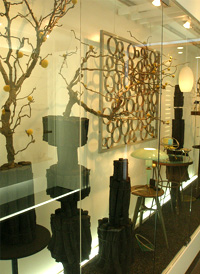Charcoal and everyday life | Koji Itoh

How can you link "modern life style" with "charcoal" that has been
fostered in the long history of Japanese culture?
When I started to create artworks for the show window, the first
thing that came up to my mind was the relationship with "charcoal
and everyday life." I wondered how I could create a world using
furniture, lighting or other goods we use in our daily life together
with Binchotan that can be associated with the image of "bud
sprouting spring."
Though several other ideas came up, such image never
disappeared from my mind, but instead became a core of the
design which developed into a concrete plan.
During my creation, I had some difficulty in processing
hard-as-metal-Binchotan into shaped form. Nevertheless, my goal
was to realize a world on my mind, aiming to "make the best use
of Binchotan' s benefits as well as create its new appearance that
no one has ever seen before."
The shaped charcoal perfectly played its role in my work and
created a magical harmony with flexible and winding branches of
Unryubai plum trees, furniture and lighting and other daily goods
in pale tone colors and modern forms.
I now feel very satisfied to somehow find my own way to express
the relationship between "charcoal and everyday life" and see my
work displayed in one of the show windows representing coming
spring in Ginza.
February 15, 2010
Koji Itoh
Finished his master program in Graduate School of Fine Arts,
Tokyo University of Arts.
Owns "Koumoriya," an antique shop and art space.
Engaged in space expression, wall painting and painting.